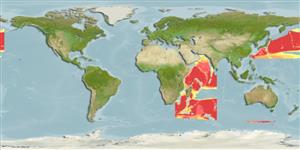Klassifizierung / Names
Namen | Synonyme | Catalog of Fishes(Gattung, Arten) | ITIS | CoL | WoRMS | Cloffa
>
Argentiniformes (Marine smelts) >
Opisthoproctidae (Barreleyes or spookfishes)
Etymology: Dolichopteryx: Greek, dolichos = long + Greek, pteryx, = wing, fin (Ref. 45335); minuscula: Name refers to the small body size, among its congeners..
Environment: milieu / climate zone / depth range / distribution range
Ökologie
seewasser bathypelagisch; tiefenbereich 1000 - 2000 m (Ref. 58272). Deep-water
Indo-West Pacific: Mauritius and Japan.
Size / Gewicht / Alter
Maturity: Lm ? range ? - ? cm
Max length : 6.0 cm SL (female)
Kurzbeschreibung
Bestimmungsschlüssel | Morphologie | Morphometrie
Rückenflossenweichstrahlen (insgesamt) : 9 - 10; Afterflossenweichstrahlen: 6 - 8; Wirbelzahl: 45. This species is characterized by eyes with small lens (lens diameter 2.2% SL), pouchlike; adipose fin present; origin of anal fin posterior to dorsal fin base; gill rakers 16-17 (= 5-6 + 1 + 10 -11) (Ref. 58272).
Life cycle and mating behavior
Maturities | Fortpflanzung | Spawnings | Egg(s) | Fecundities | Larven
Fukui, A. and Y. Kitagawa, 2006. Dolichopteryx minuscula, a new species of spookfish (Argentinoidei: Opisthoproctidae) from the Indo-West Pacific. Ichthyol. Res. 53(2):113-120. (Ref. 58272)
IUCN Rote Liste Status (Ref. 130435)
Bedrohung für Menschen
Harmless
Nutzung durch Menschen
Tools
Zusatzinformationen
Download XML
Internet Quellen
Estimates based on models
Preferred temperature (Ref.
123201): 1.2 - 1.7, mean 1.6 °C (based on 16 cells).
Phylogenetic diversity index (Ref.
82804): PD
50 = 0.5020 [Uniqueness, from 0.5 = low to 2.0 = high].
Bayesian length-weight: a=0.00437 (0.00170 - 0.01121), b=3.10 (2.88 - 3.32), in cm total length, based on LWR estimates for this (Sub)family-body shape (Ref.
93245).
Trophic level (Ref.
69278): 3.4 ±0.1 se; based on size and trophs of closest relatives
Widerstandsfähigkeit (Ref.
120179): mittel, Verdopplung der Population dauert 1,4 - 4,4 Jahre. (Fec=658).
Fishing Vulnerability (Ref.
59153): Low vulnerability (10 of 100).
